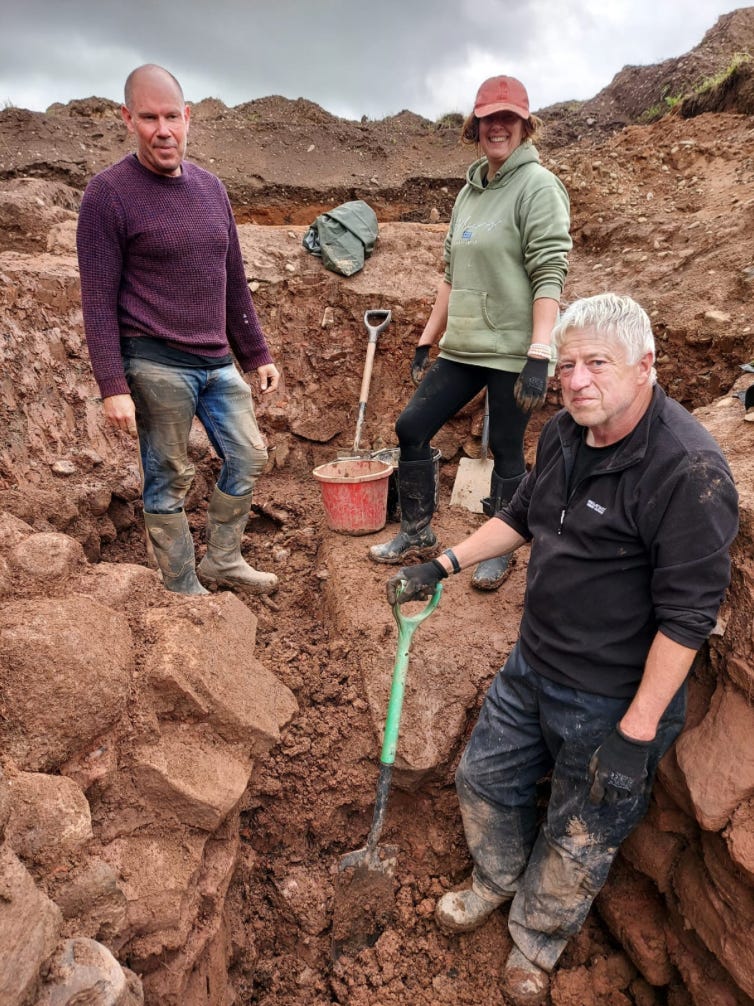New Viking Age Discovery Is Largest Hall Ever Found in Britain
A thousand-year-old timber building emerges from the soil in Cumbria—thanks to a chance cropmark and the help of local volunteers.
In the quiet fields of High Tarns Farm, tucked into the Solway Plain of Cumbria, archaeologists have made a discovery that may add a significant piece to the puzzle of Viking Age Britain. A monumental timber hall has come to light, stretching 50 meters in length and 15 meters in width. Radiocarbon dating places the structure between the years 990 and 1040, placing it squarely in the late Viking Age. According to Grampus Heritage and Training, the organization behind the excavation, this is the largest Viking Age building ever found in Britain.

The discovery's scale is significant. It may help illuminate the social and economic structures of early medieval northwest England and provide a fresh perspective on the influence and organization of Scandinavian culture in the region during a time of great transition.
The story of the discovery began in late 2022 when researchers from Grampus Heritage were reviewing open-access aerial photographs of the Tarns area. They were searching for crop marks—changes in vegetation that often signal archaeological features hidden beneath the soil. Their goal was to locate signs of a grange farm linked to Holme Cultram Abbey, which was established nearby in the twelfth century. Instead, they noticed an extensive, rectangular outline that didn’t match the usual layout of a monastic site.
In the spring of the following year, a geophysical survey confirmed anomalies worth exploring. With help from the West Cumbria Archaeological Society, the team conducted magnetometry and resistance surveys. This effort led to a full excavation in the summer of 2024, funded by a grant through the Farming in Protected Landscapes program. More than 50 local volunteers joined the dig.
Two trenches were opened. In the first, they uncovered a series of large postholes arranged in a pattern that matched the crop mark seen from above. These postholes outlined a timber hall with a triple-aisle design and ten distinct bays. Radiocarbon samples taken from one of the main support posts returned a date range from the turn of the eleventh century, confirming its place in the Viking Age.
The second trench, dug a short distance to the south, revealed a well-built grain dryer. The structure included access steps, stone-lined walls, a clay and cobble drying chamber, and the remains of an arch over the stokehole. Archaeologists also uncovered a charcoal production pit within the same trench that predates the kiln. The grain dryer was dated to the middle of the eleventh century, while the charcoal pit had a broader range stretching back into the tenth century.
These features suggest the presence of a manor farm, a type of estate often found in Viking Age Denmark. The term refers to a large hall and a rural complex tied to agricultural production, social hierarchy, and land management. Though the excavation did not yield artifacts like coins or tools, the structural evidence alone may offer insight into the lives of those who lived and worked here.
The absence of cultural material was expected. The soil conditions at High Tarns are not kind to organic preservation, and years of plowing have erased many of the upper occupation layers. Ironically, this lack of surface debris made the crop mark visible and led to the site's discovery.
Even without artifacts, the find is an important addition to what we know of Anglo-Scandinavian culture in this part of England. Cumbria is already known for its Scandinavian place names and dialect influences. Hogback stones found in churchyards across the region depict longhouse-style buildings and are often thought to represent elite Viking halls. The hall at High Tarns may be one of those buildings.
Mark Graham, the project manager from Grampus Heritage, emphasized how rare it is to find tangible evidence from this period in the region. Holme Cultram Abbey and other institutions were built atop older settlements, and this layering of history tends to hide what came before. Discoveries like High Tarns offer a glimpse into a time before the Norman conquest when Scandinavian influence was still strong in the area.
What stands out most about this story is not just the scale or age of the building but also the way it was discovered. More than fifty volunteers from the local area took part in the excavation. They dug in poor weather, sifted through gravel, and uncovered each posthole with care and determination. This is a shining example of citizen archaeology at its best. When local communities are given the chance to participate in research, incredible things can happen.
The contrast with much of the rest of Europe is also worth noting. Archaeological work is heavily restricted and tightly controlled in countries like France, Germany, and Poland. While these rules ensure professional oversight, they also tend to limit community involvement and slow the pace of discovery. How many Viking Age halls remain hidden in the countryside of Normandy or Pomerania because there’s no system to allow for this kind of grassroots investigation? We discussed this issue in two recent Vikingology Podcast episodes with Leszek Gardela and Tom Horne.
In England, the steady stream of extraordinary finds—hoards, longships, burials, and now this hall—reflects a national policy that encourages public engagement. When professionals and passionate volunteers come together, history has a way of revealing itself. The hall at High Tarns may have stood in silence for a thousand years, but now it speaks again—thanks in no small part to a community that cared enough to dig.


